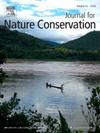破碎景观中的黑羚保护:评估保护区内及其周围的栖息地利用
IF 2.5
3区 环境科学与生态学
Q2 BIODIVERSITY CONSERVATION
引用次数: 0
摘要
稀树草原生态系统约占印度陆地面积的17%,其中只有一小部分受到保护。稀树草原生境对黑羚(Antilope cervicapra)等特有类群的生存至关重要。曾经广泛分布的黑羚,现在出现在分散的种群中,持续的保护它们的努力导致了保护区的建立,这些保护区通常是小而孤立的。我们的目标是确定黑羚在卡纳塔克邦Jayamangali黑羚保护区(JBCR)内及其周围的占用情况。我们发现稀树草原栖息地被人工林、保护区内和保护区外的农田严重破碎。我们在保护区内部和周围进行采样,并将黑羚的占用率建模为栖息地协变量的函数。在保护区内和保护区外,对黑羚占用率的估计没有什么不同。灌木数量对黑羚的探测概率有负向影响。牲畜和黑羚似乎共享同一个栖息地,可能会争夺饲料。我们的研究结果强调了保持黑羚的开放栖息地的必要性,并限制外来物种的传播,如黄花Prosopis juliflora,这可能会影响黑羚对栖息地的利用。我们的建议包括积极的栖息地管理,通过移除胡杨和树木,同时避免进一步植树。此外,我们建议采用适应性管理策略,如将社区自然旅游纳入保护区的管理实践。这样做,我们不仅可以保护黑鹿,还可以保护这些被忽视和迅速消失的景观的更广泛的生态完整性。本文章由计算机程序翻译,如有差异,请以英文原文为准。
Blackbuck conservation in fragmented Landscapes: Evaluating habitat use in and around a conservation reserve
Savanna-grassland ecosystems cover approximately 17% of India’s landmass, and only a small proportion of them are protected. Savanna-grassland habitats are critical for the survival of endemic taxa such as the Blackbuck (Antilope cervicapra). Once widespread, Blackbucks now occur in fragmented populations, and ongoing efforts to conserve them have resulted in the creation of protected areas that are often small and isolated. Our goal was to determine the occupancy of Blackbuck in and around one such protected area, the Jayamangali Blackbuck Conservation Reserve (JBCR) in Karnataka State. We found that the savanna-grassland habitat is severely fragmented by plantations, inside the reserve, and by cropland outside it. We sampled inside and around the conservation reserve and modeled the occupancy of Blackbucks as a function of habitat covariates. Estimates of Blackbuck occupancy were not different within and outside the conservation reserve. The probability of detecting Blackbucks was negatively affected by the number of shrubs. Livestock and Blackbuck appear to share the same habitat, likely competing for forage. Our findings underscore the need to maintain open habitats for Blackbucks and limit the spread of alien exotics such as Prosopis juliflora, which can impact the habitat use by Blackbucks. Our suggestions include active habitat management by way of removing P. juliflora and trees while refraining from further tree planting. Alongside, we suggest embracing adaptive management strategies such as integrating community-based nature tourism into the management practices of the reserve. In doing so, we can safeguard not only Blackbucks but also the broader ecological integrity of these overlooked and fast-disappearing landscapes.
求助全文
通过发布文献求助,成功后即可免费获取论文全文。
去求助
来源期刊

Journal for Nature Conservation
环境科学-生态学
CiteScore
3.70
自引率
5.00%
发文量
151
审稿时长
7.9 weeks
期刊介绍:
The Journal for Nature Conservation addresses concepts, methods and techniques for nature conservation. This international and interdisciplinary journal encourages collaboration between scientists and practitioners, including the integration of biodiversity issues with social and economic concepts. Therefore, conceptual, technical and methodological papers, as well as reviews, research papers, and short communications are welcomed from a wide range of disciplines, including theoretical ecology, landscape ecology, restoration ecology, ecological modelling, and others, provided that there is a clear connection and immediate relevance to nature conservation.
Manuscripts without any immediate conservation context, such as inventories, distribution modelling, genetic studies, animal behaviour, plant physiology, will not be considered for this journal; though such data may be useful for conservationists and managers in the future, this is outside of the current scope of the journal.
 求助内容:
求助内容: 应助结果提醒方式:
应助结果提醒方式:


